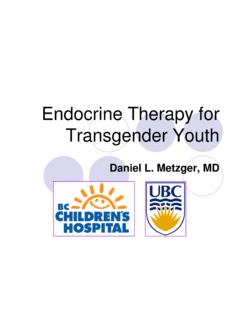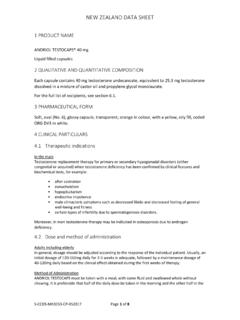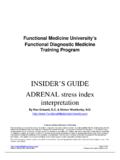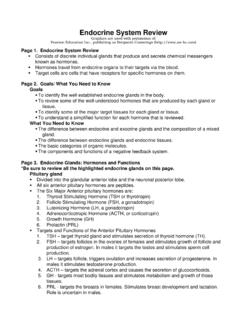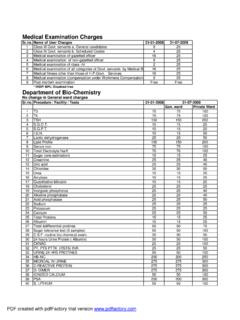Transcription of 1 PRODUCT NAME 2 QUALITATIVE AND QUANTITATIVE …
1 NEW ZEALAND DATA SHEET 1 PRODUCT NAME ANDRODERM ( testosterone ) Transdermal Patch. ANDRODERM ( testosterone ) Transdermal Patch. 2 QUALITATIVE AND QUANTITATIVE COMPOSITION testosterone is a white crystalline powder, or colourless or yellowish-white crystals, practically insoluble in water, freely soluble in alcohol and in methylene chloride, practically insoluble in fatty oils. Each Androderm mg/day transdermal patch contains mg testosterone USP. Each Androderm 5 mg/day transdermal patch contains mg testosterone USP. For the full list of excipients, see Section 3 PHARMACEUTICAL FORM Androderm is a transdermal drug delivery system consisting of a self-adhesive patch surrounding a central drug reservoir of testosterone dissolved in an alcohol-based gel. The Androderm mg/day Transdermal Patch has a cm2 active surface area and contains mg testosterone USP. The Androderm 5 mg/day Transdermal Patch has a 15 cm2 active surface area and contains mg testosterone USP.
2 Androderm provides continuous delivery of testosterone for 24 hours following application to intact, non-scrotal skin ( back, abdomen, thighs, upper arms). Two Strengths of Androderm Transdermal Patches are available which deliver in vivo mg or 5 mg of testosterone per day across skin of average permeability. 4 CLINICAL PARTICULARS Therapeutic indications Androderm is indicated for testosterone replacement therapy for confirmed testosterone deficiency in males. Dose and method of administration The usual dose is one Androderm 5 mg/day transdermal patch (or two mg/day patches) applied nightly (approximately ) and worn for 24 hours, providing approximately 5 mg testosterone per day. The dose can be adjusted up to mg/day ( , one 5 mg/day and one mg/day patch or three mg/day patches) nightly or down to mg/day ( , one mg/day patch) nightly depending on the serum testosterone measured in the morning after the application.
3 Measurement of serum testosterone should be repeated taking care to ensure proper patch adhesion and correct time of application before the dose is adjusted. Teva Pharma New Zealand Version Page 1 of 9 Treatment in non-virilised patients may be initiated with one Androderm mg/day Transdermal Patch applied nightly. The dose should be adjusted as appropriate. A dose of mg per day ( , one 5 mg/day and one mg/day patch or three mg/day patches) may be required for men with a higher body weight (>130kg). The duration of treatment and frequency of testosterone measurements is determined by the physician. Application of Androderm Apply the patch to skin immediately upon removal from the protective pouch. Damaged patches should not be used. The adhesive side of the patch should be applied to a clean, dry area of the skin on the back, abdomen, upper arms, or thighs. Bony prominences, such as the shoulder and hip areas, should be avoided as this may predispose to skin blister reactions.
4 Absorption is more variable if applied to skin on the chest and shins. Do not apply to the scrotum. The sites of application should be rotated, with an interval of 7 days between applications to the same site. The area selected should not be oily, damaged or irritated. The patch should be applied immediately after opening the pouch and removing the protective release liner. The patch should be pressed firmly in place, making sure there is good contact with the skin, especially around the edges. Contraindications Known hypersensitivity to testosterone or other constituents of the patch. Androgens are contraindicated in men with carcinoma of the breast or known or suspected carcinoma of the prostate, nephrotic syndrome and hypercalcaemia. Androderm has not been evaluated in women and must not be used in women. testosterone may be harmful to the foetus. Special warnings and precautions for use Use in the Elderly Geriatric patients, and others with an increased risk of developing prostatic hypertrophy and/or prostate cancer, should be assessed before starting testosterone replacement therapy because testosterone may promote the growth of the prostate and of subclinical prostate cancer.
5 Patients receiving testosterone replacement therapy should be reviewed for prostatic disease in accordance with contemporary clinical practice for their age. Hypercalciuria/hypercalcaemia (caused by skeletal metastases) may be exacerbated by androgen treatment. testosterone may cause a rise in blood pressure and Androderm should be used with caution in patients with hypertension. There is insufficient long-term safety data to assess a potentially increased risk of cardiovascular disease. Teva Pharma New Zealand Version Page 2 of 9 Oedema, with or without congestive heart failure, may result from androgen treatment in patients with pre-existing cardiac, renal, or hepatic disease. In addition to discontinuation of the drug, diuretic therapy may be required. Androderm should be used with caution in patients with ischaemic heart disease, epilepsy and migraine as these conditions may be aggravated. Patients should be monitored for polycythemia and for sleep apnoea.
6 Use in Children Androderm is not indicated for use in children as there has been no clinical experience of its use below the age of 15. Interaction with other medicines and other forms of interaction When used simultaneously with anticoagulants, the anticoagulant effect can increase. Patients receiving oral anticoagulants require close monitoring especially when androgens are started or stopped. Concurrent administration of oxyphenbutazone and androgens may result in elevated serum levels of oxyphenbutazone. In diabetic patients, the metabolic effects of androgens may decrease blood glucose and, therefore, insulin requirements. Skin burns have been reported at the patch site in several patients wearing an aluminised transdermal system during a magnetic resonance imaging scan (MRI). Because Androderm contains aluminium, it is recommended to remove the system before undergoing an MRI. Fertility, pregnancy and lactation Effect on Fertility Exogenous administration of androgens inhibits endogenous testosterone release.
7 With large doses of exogenous androgens, spermatogenesis may be suppressed. Use in Pregnancy Pregnancy Category D Androderm therapy has not been evaluated in and must not be used in women under any circumstances. testosterone may have a virilising effect on the female foetus. Use in Lactation No data available. Effects on ability to drive and use machines The use of Androderm is presumed to be safe and unlikely to PRODUCT adverse effects, which may impair the patient's ability to drive and use machines. Undesirable effects Transient mild to moderate erythema was observed at the site of application in the majority of patients at some time during treatment. The following adverse events were observed during clinical trials with Androderm : Events are listed within body systems and categorised by frequency according to the following definitions: very common events reported at a frequency of greater or equal to 1/10 patients; common events reported at a frequency of less than 1/10 but greater or equal to 1/100 patients; uncommon events reported at a frequency of less than 1/100 but greater or equal to 1/1,000 Teva Pharma New Zealand Version Page 3 of 9 Body as a whole: Common: Headache Uncommon: Body pain, accelerated growth , depression, fatigue, confusion, increased appetite, decreased libido, thinking abnormalit ies, pelvi c pain.
8 Cardiovascular system: Uncommon: Hypertension, peripheral vascular disease. Central and Peripheral Nervous System: Uncommon: Vertigo, paraesthesia Gastrointestinal: Common: Gastrointestinal bleeding Psychiatric: Uncommon: Anxiety Reproductive: Common: Prostatic abnormalities Uncommon: Impotence, testicular abnormalities. There was a single case of prostatic carcinoma. Skin: Very common: Pruritus at application site, burns like blister reaction under system. Common: Erythema at application site, vesicles at application site, allergic contact dermatitis to the system, rash, induration at applic ation site, burning at application site. Uncommon: Acne, bullae at application site, mechanical irritation at application site, rash at application site, contamination at applic ation site. Urinary tract system: Uncommon: Urinary tract infection, dysuria, urinary incontinence, haematuria. patients; rare events reported at a frequency of less than 1/1,000 but greater than or equal to 1/10,000 patients; very rare events reported at a frequency of less than 1/10,000 patients.
9 Skin irr itancy Three types of application site reactions occurred: irritation which included mild to moderate erythema, induration or burning; allergic contact dermatitis; and burn-like blister reactions. Chronic skin irritation caused 5% of patients to discontinue treatment. Mild skin irritation may be ameliorated by treatment of affected skin with over the counter topical hydrocortisone cream or topical antihistamine products. Five patients (4%) developed allergic contact dermatitis after 3 to 8 weeks treatment that required discontinuation. These reactions were characterised by pruritus, erythema, induration and in some instances vesicles or bullae, which recurred with each system application. Rechallenge with components of the system showed ethanol sensitisation in four patients. One patient s reaction was attributed to testosterone . None of these patients had adverse sequelae related to oral alcohol ingestion or to injectable testosterone use.
10 Older patients may be more prone to develop allergic contact dermatitis. Fourteen patients (12%) had burn-like blister reactions that involved bullae, epidermal necrosis or the development of ulcerated lesions. These reactions typically occurred once, at a single application site; five patients experienced a single recurrence. None withdrew from the clinical trials. These reactions occurred at a rate of approximately 1 in 6,500 system applications (1 in 3,250 treatment days). The majority of these lesions were associated with system application over Teva Pharma New Zealand Version Page 4 of 9 bony prominences or on parts of the body that may have been subject to prolonged pressure during sleep or sitting ( over the deltoid region of the upper arm, the greater trochanter of the femur, or the ischial tuberosity). The more severe lesions healed over several weeks with scarring in some cases. Such lesions could be treated as burns.












